
Transcription
MITRE ATT&CK Matrix IntrospectionAn evolution in identifying and tracking cyber attackersbaesystems.com/cyber
BackgroundIt’s a common belief in the security industry that new attacks involve new techniques, e.g. new vulnerabilities beingexploited or new tricks for lateral movement. From our perspective, the vast majority of attacks leverage existing andoften well-known techniques and are only successful because of poor implementation of controls or gaps in detection.Therefore a better articulation of these known techniques, as well as adoption of machine-readable intelligence formatsshould both improve security coverage for organisations and reduce the burden on network defenders.The leading initiative in tackling this is the MITRE ATT&CK Matrix for categorising and describing threat actortechniques, which has continued to evolve and increase in popularity. Many teams are now using it routinely for threatmodelling, security testing, and other use cases. Many vendors of security products now include some level of linkage tothe ATT&CK matrix.We recently ran an exercise to review our back catalogue of threat research reports overthe past six years. Given the volume of content, this required automatic extraction bypattern matching followed by manual validation from our analyst team. This analysiswas performed against the ATT&CK Matrix v6. There have been a number of changesmade to the ATT&CK Matrix since this time, which we discuss later in the report.This report provides a summary of our findings as well as recommendations on how tomake use of the MITRE ATT&CK Matrix.Page 2The MITRE ATT&CK Matrix
AnalysisOver the past six years we have produced over 500 detailed research reports based on cases from our incident response team andthreat intel investigations.As marked on the below graph, different ATT&CK tactics vary considerably in their total coverage in our reports: Tactics that are commonly covered are Command and Control, Defense Evasion and Execution. This strongly reflects thenature of our threat reporting, where we typically report on new malware from a threat group of interest, and analyse malwarebehaviour and C&C methods. Tactics that are regularly covered are Discovery, Initial Access, Collection, Persistence, and Exfiltration. In some cases, we willhave enough information to be able to cover these parts of the ATT&CK framework – but some parts of the ‘kill chain’ may beelusive (for example, the initial access technique(s) used is not always known). Tactics that are rarely covered in our threat reports are Credential Access, Lateral Movement, Impact, and Privilege Escalation.These tactics largely cover techniques that would only typically be seen in victim networks. Reports in which these techniquesare discussed are likely to be based on insights from our incident response team. The Impact tactic is a relatively new addition tothe ATT&CK Enterprise Matrix (added in 2019), and covers techniques where the attacker is seeking to “manipulate, interrupt,or destroy your systems and data”1. We have back-dated our report data to include tagging of these techniques. Techniques ofthis type do appear in our reports (e.g. those on ransomware, or Lazarus’ use of wipers), but these are relatively rare. However, itis likely that the prevalence of this tactic will increase in future years, reflecting the increased willingness and capability of threatgroups across the landscape to perform such actions.Figure 1Overall percentages of ATT&CK techniques appearing in our reports, by tactic heading.The MITRE ATT&CK MatrixPage 3
Evolution inTTP ObservationsThe graph below shows the normalised frequency of ATT&CK tactic prevalence inour reports across 2014 to 2019 inclusive. Normalisation by year accounts for variation(increase) in our research reporting output over the 2014-2019 timespan.Figure 2Normalised frequency of ATT&CK tactics in our research reports.Again, it can be seen that Command and Controland Defense Evasion are the tactics which aremost commonly covered in our analysis. Theyear-by-year data shows that these levels havebeen relatively consistent in our reports over time.Page 4The MITRE ATT&CK Matrix
By analysing the data by ATT&CK technique (instead of bytactic grouping), we can gain further insight into techniquepopularity in the threat landscape and assess changes overtime. The graph below shows the normalised frequency of thetop five ATT&CK techniques in our data (in total), for each year2014-2019.Figure 3Normalised frequency of the top five ATT&CK techniques in our research reports.Commonly Used Port is likely to have increased in recent years due to increased use of SSL certificates, now readily availableto attackers through Let’s Encrypt and other services. Most actors will have gradually shifted away from custom ports andprotocols towards HTTPS – the benefits of this encryption are obvious, and it also makes incident response far trickier.Scripting continues to appear frequently in our reports as attackers continue to ‘live off the land’, as well as using penetrationtesting tools to simplify their attacks and blend in. Over time, attacks have generally progressed towards multi-stagedeployments as opposed to a single backdoor that is deployed immediately.Many infection chains involve obfuscated files and information, which explains why Obfuscated Files or Information is aprevalent technique. The Lazarus group is of special note here, given the group’s extensive use of packed malware.The MITRE ATT&CK MatrixPage 5
In the graphic below, we chart the biggest increases and decreases in ATT&CK technique frequency that we have seen between2014 and 2019.Biggest increase in normalised frequency(2014-2019)Figure 4ATT&CK techniqueswith the biggestincrease (top) anddecrease (bottom)in prevalence in ourresearch reports,2014-2019Biggest decrease in normalised frequency(2014-2019)Page 6The MITRE ATT&CK Matrix
The largestincreaseswere seen intwo relatedtechniques:Scripting andPowerShell.More groups are shifting to living-off-the-land techniques thatincludes the increasing use of PowerShell. It’s interestingthat in 2014, we saw no mentions of PowerShell in any ofour reporting.Drive-by compromise has decreased significantly in our data.Also known as watering-holes in more targeted cases, thisattack type traditionally relied on vulnerabilities in ShockwaveFlash or Java to deliver and execute malware on systems. Socalled exploit-kits were common a few years ago, but arenow less frequently seen. Improved browser defences, fewervulnerabilities, and shifting attacker trends have resulted in thedecrease observed, although the technique is still used in somecases. Exploitation for client execution has likely decreased inline with increased use of social engineering and macros, ratherthan exploitation of client software (Java, Adobe Flash, etc.).The significant increase and decrease seen in specific techniquesover time is worth highlighting further.Figure 5Prevalence of the PowerShell technique in our reports.Following a rise and rise since 2014, Powershell remained a very prominent technique inour 2019 data, but may have levelled off to a degree. This may reflect a ‘peak’ in popularityfor PowerShell – potentially due to increased awareness and detection of PowerShell andthreat actor use of penetration testing tools. However, this can only be hypothesised, andadditional data (including future data) would be needed to confirm this.The MITRE ATT&CK MatrixPage 7
Drive-by Compromise has continued to decline in prevalence in ourreporting, and in fact was absent from our 2019 data2. However, thetechnique is still being used, but is relatively rare. In 2019, Chinese threatgroups used watering holes to target mobile device users from specificpopulations with novel exploits3. Moreover, in 2020, we are tracking activeuse of watering holes – by the Snake group, as well as MuddyWater. Weexpect to see a small increase in this technique next year.In terms of cryptographic protocols when used in C&C, standardprotocols (TLS) continue to dominate over custom cryptographic protocols.However, high-end threat groups such as Lazarus and Snake are still fondof using custom protocols in different aspects of C&C.Figure 6Prevalence ofthe Drive-byCompromisetechnique inour reports.Figure 7Prevalenceof standardand customcryptographicprotocols forC&C in ourreportsPage 8The MITRE ATT&CK Matrix
Analysis by Threat Group CategoryAnother angle to analyse the data from is by looking at differences in ATT&CK TTP prevalence bythreat group category.Our threat intelligence research is focused on state actors from Russia, China, Iran and DPRK, as well as criminalthreat actors.In the table below, the top 20 techniques in our data overall are listed, together with their rank in prevalence in ourreports covering different threat actor categories.Rank in CategoryTop 20 Techniques OverallRussiaChinaIranDPRKCriminal1Standard Application Layer Protocol132552Scripting381213Commonly Used Port316354Exploitation for Client Execution5115Obfuscated Files or Information51576Spearphishing Attachment10557System Information Discovery9215798Standard Cryptographic Protocol21275119Data from Local System5410121110User Execution511Registry Run Keys/Startup Folder1912Drive-by Compromise1313Command-Line Interface1414Input Capture1715PowerShell16Process Injection1117Exfiltration over C&C Channel1118Masquerading1219Uncommonly Used Port1520Spearphishing Link8641524312151516153731581181420The MITRE ATT&CK Matrix1912121251115Page 9
Key PointsSome of the key points that emerge from this data are as follows: The top three techniques (Standard Application Layer Protocol, Scripting, Commonly Used Port)are popular among all threat categories considered here. Although these techniques reflect the overallfocus of our analysis, it could also be argued that these constitute key building blocks of attacker activityin the threat landscape today. The trend toward scripting (including ‘living off the land’) and use ofstandard and common protocols/ports all make sense in terms of attackers looking to blend their activityin with legitimate host and network activity. Beneath the top three, variability comes in across different threat categories. For example, the fourthmost common technique overall, Exploitation for Client Execution, does not feature in the top 20techniques for Iranian or North Korean actors, who tend to prefer PowerShell and other living-off-theland techniques rather than exploitation of software vulnerabilities. The DPRK rankings (dominated by our Lazarus group reporting) are quite distinct: Obfuscated files or information is the most commonly described technique in activity from theDPRK nexus, in part reflecting Lazarus’ preference for packed malware. Spearphishing attachment is missing from the top 20 for DPRK groups. This reflects the fact thatit is often hard to recover the full infection chain for Lazarus activity, and that initial access methodsused in Lazarus campaigns remain more poorly understood than other top-tier groups. Iranian TTPs are generally considered of a lower sophistication than other major threat nexuses – andthis is borne out to an extent in the data, where both Scripting and PowerShell are ranked highly. As discussed previously, PowerShell has risen significantly in prevalence over the years, butwhen broken down by category, it can be seen that it is only popular with Iranian, North Korean, andcriminal operators. For Russian and Chinese groups, PowerShell is outside the top 20 most commonlyreported techniques. Spearphishing attachment comes up commonly in reports of criminal activity (ranked 2nd). Thisis likely to be because this is easier to identify in these cases. Criminal campaigns often use maliciousattachments, but they are also more readily reported/uploaded to sandboxes, etc., when comparedwith campaigns from state actors. Criminal activity also features a higher degree of Masquerading,reflecting a generally lower degree of sophistication in Defense Evasion, where other moresophisticated techniques are possible.StandardApplication LayerProtocol, Scriptingand CommonlyUsed Port arepopular among allthreat categories.Page 10The MITRE ATT&CK Matrix
ATT&CK Enterprise Matrix CommentsIn our analysis, a considerable number ofATT&CK techniques have never appeared inour reporting - approximately 40%. On firstglance this may indicate that the ATT&CKmatrix has a large number of redundant orun-used techniques, and that refinementand simplification may be in order. On theother hand, and almost certainly the casein some instances, these gaps will reflectthe ‘lens’ through which we conduct ourthreat intelligence research and reporting –with a focus on malware and attacker C&Ccommunications. MITRE’s philosophy has alwaysbeen to base their matrices on techniquesthat are observed in the wild; collation of andcomparison of prevalence data from differentsources in industry and government could leadto refinement in future.The MITRE ATT&CK Matrix has recently evolvedto include ‘sub-techniques’ to provide moregranularity, addressing the fact that techniquedescriptions vary in breadth. Some tactics havealso been added and removed, reflecting thatthe ATT&CK Matrix is still being evolved to bestharness its usefulness for cyber defence.Click hereto visit theMITREwebsite andfind out moreConclusionsThe MITRE ATT&CK Matrix is a very useful resource for many purposes. We have shown above that historic analysisof techniques across our threat research over the years can emphasise trends, which then provide a degree ofquantification to high-level observations about the threat landscape – highlighting techniques that have increased anddecreased in popularity, as well as tangible differences in technique frequency across different threat nexuses.As the community continues to increase its adoption of the MITRE ATT&CK Matrix, it is likely that data fed back in toMITRE will result in further evolutions to the matrix, which will improve its usefulness. The data that we have analysedhere strongly reflect our approach to threat intelligence research and emphasis on malware samples as a primarysource for investigations. Aggregation of techniques from teams that have different approaches and telemetry wouldultimately result in a more holistic view of the threat landscape, and the ATT&CK matrix provides a great opportunityfor the community to do this.The MITRE ATT&CK MatrixPage 11
We areAt BAE Systems, we provide some of the world’s most advancedtechnology, defence, aerospace and security solutions.We employ a skilled workforce of 82,500 people in over40 countries. Working with customers and local partners,our products and services deliver military capability, protectpeople and national security, and keep critical information andinfrastructure secure.Global HeadquartersBAE SystemsSurrey Research ParkGuildfordSurrey GU2 7RQUnited KingdomT: 44 (0) 1483 816000BAE Systems8000 Towers Crescent Drive13th FloorVienna, VA 22182USAT: 1 720 696 9830BAE Systems19, Boulevard Malesherbes75008 ParisFranceT: 33 (0) 1 55 27 37 37BAE SystemsMainzer Landstrasse 5060325 Frankfurt am MainGermanyT: 49 (0) 69 244 330 0/2While some of our 2019 reports were focussed on malware that was likely to havebeen delivered from watering holes, we could not confirm this from our visibility andthus did not tag them with the Drive-by Compromise ps://attack.mitre.org/beta/matrices/enterprise/BAE Systems, Surrey Research Park,Guildford, Surrey, GU2 7RQ, UKE: learn@baesystems.com W: saitwitter.com/baesystems aiMITRE ATT&CK and ATT&CK are registered trademarks of The MITRE Corporation. The referencesto these trademarks in this work are not intended to imply an affiliation with, sponsorship, orendorsement by MITRE. This work should not be interpreted as representing the views and opinionsof MITRE or MITRE personnel”.Copyright BAE Systems plc 2020. All rights reserved.BAE SYSTEMS, the BAE SYSTEMS Logo and the product names referenced herein are trademarksof BAE Systems plc. BAE Systems Applied Intelligence Limited registered in England & Wales(No.1337451) with its registered office at Surrey Research Park, Guildford, England, GU2 7RQ. Nopart of this document may be copied, reproduced, adapted or redistributed in any form or by anymeans without the express prior written consent of BAE Systems Applied Intelligence.Victim of a cyber attack?Contact our emergency response team on:UK:International:Email:0808 168 6647 44 (0) 330 158 5263cyberresponse@baesystems.com
for PowerShell - potentially due to increased awareness and detection of PowerShell and threat actor use of penetration testing tools. However, this can only be hypothesised, and additional data (including future data) would be needed to confirm this. Figure 5 Prevalence of the PowerShell technique in our reports. The MITRE ATT&CK Matrix










